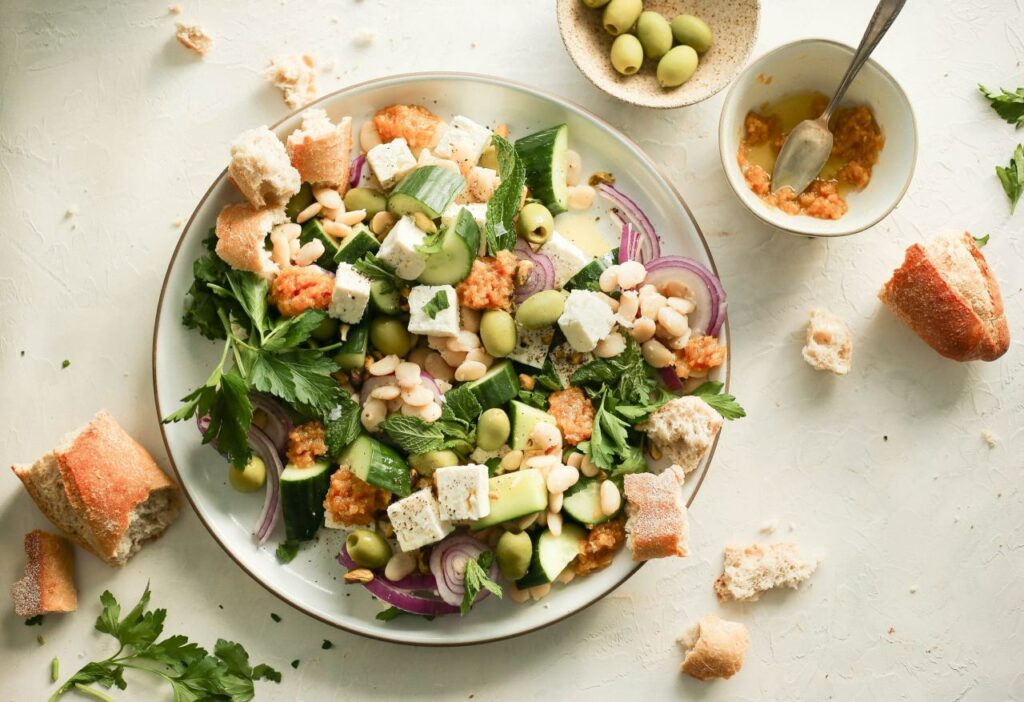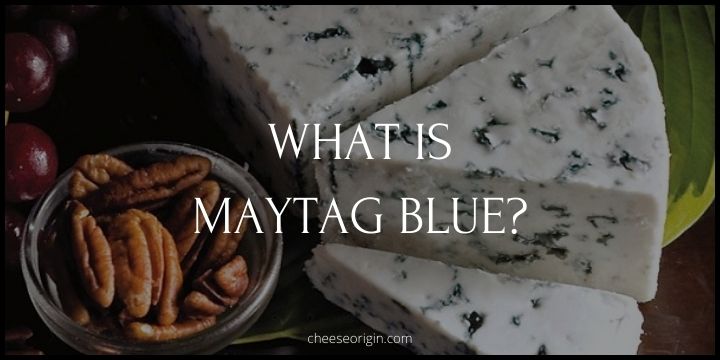What is Feta? The Cheese with a 6,000-Year Heritage

This guide is dedicated to the Greek culinary gem that has taken the world by storm – Feta cheese.
Famed for its tangy, sharp flavor and creamy texture, feta is not just a cheese; it’s a testament to the rich history and tradition of Greek cheesemaking dating back to the 8th Century BC.
This versatile cheese made predominantly from sheep’s milk or a blend of sheep and goat’s milk, is a staple in Greek cuisine, occupying a whopping 70% stake in their cheese consumption.
But, the feta phenomenon extends far beyond the borders of Greece. Its unique, briny taste and soft texture have earned it a cherished place in kitchens around the globe.
Whether crumbled over salads, melted into a frittata, or enjoyed on its own, feta has a way of elevating any dish.
In this guide, we’ll delve deep into the world of feta cheese, exploring its history, production, and varieties, and of course, sharing some mouthwatering recipes that will make you fall in love with feta all over again.
So, ready to embark on this flavorful journey? Let’s dive in!
Quick Facts About Feta
| Fact | Description |
|---|---|
| Origin | Greece |
| Milk Source | Sheep’s milk, or a mix of sheep and goat’s milk |
| Texture | Crumbly, grainy |
| Flavor | Salty, tangy |
| Color | White |
| Aging Process | Minimum 2 months |
| Protected Designation of Origin | Registered as a Protected Designation of Origin (PDO) under EU law since 2002 |
| Historical Origins | Feta cheese is believed to be one of the oldest cheeses, dating back to ancient Greece |
| Uses | Salads (particularly Greek salad), pastries, served with olive oil or olives |
What is Feta Cheese?

Feta cheese, a staple in Greek cuisine, is an intriguing and unique dairy product with a rich history and distinct flavor profile. Originating from Greece, Feta is a brined curd cheese made primarily from sheep’s milk or a blend of sheep’s and goat’s milk. Its crumbly texture, tangy taste, and slightly salty flavor have endeared it to food lovers worldwide.
The process of making Feta cheese is fascinating. It involves curdling the milk with rennet, a complex set of enzymes produced in the stomachs of ruminant mammals. The curd is then separated, salted, and left to mature in brine. This aging process, which can take several months, imbues Feta with its characteristic tangy flavor and firm texture.
Feta cheese is incredibly versatile, making it a delightful addition to various dishes. In salads, it adds a creamy, salty contrast to fresh vegetables. When baked, it becomes surprisingly creamy and spreadable, perfect for smearing on a piece of crusty bread. It can also be used in pastries, omelets, pizzas, and pasta.
But, Feta cheese is not just about taste; it’s also packed with nutrients. It’s a good source of protein, calcium, and vitamins B2 and B12. However, due to its high sodium content, it should be eaten in moderation.
Interestingly, Feta cheese has been granted Protected Designation of Origin (PDO) status by the European Union. This means that only cheese produced in specific areas of Greece, using traditional methods and local sheep’s and goat’s milk, can be called “Feta.”
In essence, Feta cheese is a culinary treasure, offering a delightful blend of taste, texture, and nutrition. Its unique characteristics and versatility make it a must-try for any cheese lover.
Also read: Cheddar: The Global Favorite in the World of Cheeses
What Does Feta Taste Like
Feta cheese has a unique flavor profile that sets it apart from other cheeses. It is known for its tangy, slightly tart taste that can be described as sharp or acidic. This tanginess is a result of the brining process during its production.
In addition to its tang, Feta also has a noticeable salty flavor due to the brine in which it’s aged. This saltiness can vary depending on how long the cheese has been aged in the brine.
The texture of Feta contributes to its taste as well. It’s semi-soft but crumbly, and when bitten into, it has a slight graininess that quickly turns creamy in the mouth.
Feta made primarily from sheep’s milk tends to be richer and creamier, while Feta made with a mix of sheep’s and goat’s milk often has a more pronounced tang and a slightly goaty flavor.
Overall, the taste of Feta is complex and multifaceted, offering a delightful balance of tanginess, saltiness, and creaminess. It adds a burst of flavor to any dish it’s added to, making it a favorite among cheese enthusiasts.
Feta tasting notes
- Texture: Semi-soft yet crumbly. It has a slight graininess that transforms into a creamy texture when bitten into.
- Color: Pure white. The color can be slightly off-white depending on the type of milk used and the aging process.
- Aroma: Mild but distinctive, often with a slight hint of the brine in which it is matured. Some versions, especially those made with goat’s milk, may have a faintly goaty aroma.
- Taste: Tangy and slightly tart, with a sharpness that can be described as lactic or yoghurt-like. This tanginess is balanced by a pronounced salty flavor from the brine.
- Aftertaste: The tanginess typically lingers on the palate, often accompanied by a mild saltiness.
- Mouthfeel: The initial crumbliness gives way to a creamy, somewhat buttery mouthfeel when the cheese starts to melt in the mouth.
- Variations: Feta made primarily from sheep’s milk tends to be richer and creamier, while Feta made with a mix of sheep’s and goat’s milk often has a more pronounced tang and a slightly goaty flavor.
- Pairings: Pairs well with fresh fruits like watermelon, grapes, and apples. Also goes well with olives, tomatoes, and robust wines. Makes a great addition to salads, sandwiches, and Mediterranean dishes.
Is Feta the Healthiest Cheese?
Feta cheese is often touted as one of the healthiest cheeses due to its nutrient content and lower calorie count compared to other cheeses. It’s packed with calcium, which is essential for muscle and nerve function, as well as for maintaining strong bones and teeth. Feta also contains decent amounts of vitamins A and K, and folate.
Moreover, feta is rich in protein and vitamin B, which can help fight infections and diseases. It also includes Conjugated Linoleic Acid (CLA), a fatty acid linked to positive changes in body composition.
However, it’s important to note that while feta has many health benefits, it does contain more fat and cholesterol than some other cheeses. It’s also high in sodium due to the brining process, so it should be consumed in moderation, especially by individuals monitoring their sodium intake.
So, is feta the healthiest cheese?
It depends on your dietary needs and restrictions. But with its unique combination of nutrients and lower calorie content, it’s certainly a healthy choice among the various cheese options.
Sources
Feta Nutrition Facts
The key nutrients in a 100 grams serving of Feta cheese:
| Nutrient | Quantity |
|---|---|
| Calories | 264 kcal |
| Protein | 14.21g |
| Total Fat | 21.49g |
| Saturated Fat | 14.946g |
| Cholesterol | 89mg |
| Sodium | 1,113mg |
| Potassium | 62mg |
| Total Carbohydrate | 4.09g |
| Dietary Fiber | 0g |
| Sugars | 4.09g |
| Calcium | 493mg |
| Vitamin A | 422 IU |
Which is healthier: Goat cheese or Feta?
When comparing goat cheese and feta, both have their own health benefits, and the “healthier” choice can depend on your specific dietary needs and goals.
| Goat Cheese | Feta | |
|---|---|---|
| Origin | Typically France | Greece |
| Milk Source | Goat’s milk | Sheep’s milk (can be blended with up to 30% of goat’s milk in the EU, outside of EU, cow’s milk is used) |
| Taste | Mild, creamy, tangy | Salty, tangy, slightly sharp |
| Texture | Soft, spreadable | Crumbly, yet can be sliced |
| Calories (per 100g) | 364 | 265 |
| Protein (per 100g) | About 22g | About 14g |
| Saturated Fat (per 100g) | About 21g | About 15g |
| Vitamins | Good source of Vitamin A, Vitamin D, and some B vitamins | Higher in riboflavin, thiamine, and vitamins B6 and B12 compared to goat cheese |
| Health Considerations | Higher calorie and fat content, but also higher in protein. Suitable for those who are lactose intolerant. | Lower in calories and fat than goat cheese. Contains ‘friendly’ bacteria. |
Goat cheese is known for its high protein content. However, it contains more calories and saturated fat than feta. Specifically, goat cheese has 364 calories per 100 grams, while feta has 265 calories per 100 grams.
On the other hand, feta cheese provides more riboflavin, thiamine, and vitamins B6 and B12 compared to goat cheese. It also has fewer calories and saturated fat than goat cheese.
Feta cheese is also known to contain ‘friendly’ bacteria that produce antibiotics that help kill Listeria – a food poisoning-causing bacteria.
In terms of macronutrient ratios, both cheeses have relatively similar nutrition.
Therefore, if you are watching your calorie intake or trying to limit saturated fats in your diet, feta could be a better choice. However, if you’re looking for a higher protein content, goat cheese might be more suitable.
Remember, moderation is key when consuming any type of cheese due to its high fat and sodium content. It’s always a good idea to consult with a healthcare provider or a dietitian to understand what fits best into your individual diet plan.
>> Click here to read our in-depth guide on Chèvre (goat cheese)
What Can I Use Feta Cheese For?
Feta is incredibly versatile and can be enjoyed in a variety of ways. Here are the 10 most common ways:
- In Salads: Feta is most commonly used in salads. The classic Greek salad includes feta cheese, tomatoes, cucumbers, red onions, olives, and a simple vinaigrette.
- With Bread: Spread some feta on warm bread or toast for a delicious snack. You can also drizzle it with a bit of olive oil and sprinkle some herbs on top.
- In Baked Goods: Crumble some feta into your muffin or scone batter before baking, or sprinkle it on top of bread dough.
- In Sandwiches and Wraps: Add some feta to your sandwiches or wraps for a burst of flavor.
- As a Pizza Topping: Instead of or in addition to mozzarella, sprinkle some feta on your pizza before baking it.
- In Pasta Dishes: Can be used in pasta dishes, either melted into the sauce or crumbled on top as a garnish.
- In Grain Dishes: Add some feta to your quinoa, rice, or couscous dishes.
- As a Snack: Enjoy feta on its own, or with some crackers. It’s also delicious when paired with fruit like watermelon or grapes.
- In Egg Dishes: Crumble some feta into your scrambled eggs, omelettes, or frittatas.
- Marinated: Marinate cubes or slices of feta in olive oil, herbs, and spices, then use it as a spread or in salads.
The Differences Between Feta and Mozzarella
| Feta | Mozzarella | |
|---|---|---|
| Origin | Greece | Italy |
| Traditional Milk Source | Sheep or Goat’s Milk | Buffalo or Cow’s Milk |
| Flavor | Tangy, Sharp, Slightly Salty | Mild, Milky |
| Texture | Crumbly, Somewhat Grainy | Soft, Moist, Stretchy when Melted |
| Common Uses in Recipes | Salads, Mediterranean Dishes, Baked Goods | Italian Cuisine, Pizza, Pasta Dishes |
| Fat Content (per 100g)12 | Approx. 21.5g | Approx. 22.3g |
| Protein Content (per 100g)12 | Approx. 14.2g | Approx. 22.2g |
| Calories (per 100g)12 | Approx. 264 | Approx. 280 |
>> Click here to read our in-depth guide on Mozzarella
7 best Feta substitutes (alternatives)
| Substitute | Description |
|---|---|
| Goat Cheese | It has a similar crumbly texture to feta but is less salty. The creamy and tangy flavor makes it a good substitute in salads or baked dishes. |
| Ricotta Salata | This is a saltier, more solid version of ricotta. It’s not as tangy as feta, but its crumbly texture makes it a decent substitute, especially in salads. |
| Halloumi | While it’s less crumbly than feta, halloumi has a similar salty flavor. It’s best used as a feta substitute in cooked dishes, as it holds up well to heat. |
| Queso Fresco | This fresh Mexican cheese has a mild flavor that’s less tangy than feta. Its crumbly texture makes it a good substitute in a variety of dishes. |
| Roquefort | A French blue cheese that is tangier and more intense in flavor than feta. It can be crumbled like feta and used in salads or on top of dishes for a unique flavor twist. |
| Cotija | Another Mexican cheese, cotija is dry and crumbly with a strong, salty flavor. It can be used in much the same way as feta. |
| Tofu (for vegan option) | Tofu can be marinated and crumbled to mimic the texture and flavor of feta. It’s a great vegan alternative for feta in salads or Mediterranean dishes. |
What are the Benefits and Drawbacks of Feta Cheese?
Benefits:
- Rich in Nutrients: Feta cheese is packed with various essential nutrients, including protein, calcium, phosphorus, and vitamins B6 and B12.
- Lower Fat Content: Compared to many other cheeses, feta has a lower fat and calorie content, making it a healthier choice for those watching their intake.
- Contains Probiotics: Feta cheese contains beneficial bacteria due to the fermentation process, which can promote gut health.
- Versatile: Its unique flavor profile makes feta a versatile ingredient that can be used in a variety of dishes, from salads and pastas to baked goods.
Drawbacks:
- High in Sodium: Feta cheese is stored in brine, making it high in sodium. Excessive sodium intake can lead to high blood pressure and heart disease.
- Potential Allergens: Feta is made from sheep’s or goat’s milk, which can cause allergic reactions in some people who are sensitive to these types of milk.
- Not Suitable for Vegans: Like all cheeses, feta is a dairy product and is not suitable for those following a vegan diet.
- Lactose Content: While the lactose content in feta is lower than in many other cheeses, it may still cause problems for individuals who are lactose intolerant.
Also read: Savor the Flavor: 20 Cheeses with the Least Lactose
Top 3 Simple & Delicious Feta Recipes Idea
1. Feta Salad With White Beans and Lemon Relish:

This refreshing salad combines the creaminess of white beans with the tangy flavor of feta cheese, all brought together by a zesty lemon relish. It’s a light and nutritious option for a quick lunch or dinner.
2. Baked Feta:

An incredibly easy appetizer or snack, baked feta involves baking a block of feta cheese until it’s soft and spreadable. You can add herbs, spices, or a drizzle of honey for added flavor.
3. Greek Wedge Salad:

This twist on a classic wedge salad uses Greek flavors like feta cheese, olives, and a Greek-style vinaigrette. It’s a great side dish for any meal.
What goes well with Feta?
Food that goes well with Feta
| Category | Foods |
|---|---|
| Breakfast | Salsa, eggs, black beans, cilantro |
| Lunch/Dinner | Steak, chicken, tofu, fish, salads, soups, seafood, vegetables |
| Vegetables | Artichoke, asparagus, avocado, beetroot, broccoli, cauliflower, corn, cucumber, eggplant |
| Fruits | Watermelon, figs, pears, grapes |
| Grains | Quinoa, bulgur, couscous |
| Herbs/Spices | Basil, mint, oregano |
| Desserts | Honey, walnuts |
| Sides | Greek fries, flatbread |
| Salads | Spinach, olive and feta salad with oregano salsa verde |
Also read: What Fruit Goes on a Charcuterie Board?
Beverage that goes well with Feta
| Category | Beverages |
|---|---|
| Wine | Assyrtiko (Santorini or elsewhere in Greece), Sauvignon Blanc (Sancerre or Pouilly-Fumé), Beaujolais/Gamay, Unoaked Moschofilero, Chenin Blanc (Stellenbosch, South Africa), Pinot Grigio |
| Non-Alcoholic | Tea, Coffee, Hot chocolate, Lemonade, Soda |
| Beer | Light lagers, Wheat beers |
| Spirits | Ouzo (a traditional Greek anise-flavored spirit) |
The history of Feta
Feta cheese has a rich history dating back to Ancient Greece. Its name, derived from the Italian word ‘fetta’, means ‘slice’. This name was given in the 17th century, but the cheese has been around for much longer.
The earliest references to feta-like cheese date back to the 8th century B.C., when the poet Homer mentioned that the Cyclops Polyphemus was making cheese from sheep’s milk. The cheese-making process described in Homer’s Odyssey is similar to the process used to produce feta cheese today.
In the Byzantine Empire, there are records of cheeses being aged in brine, which is a key element in the production of feta. By the time of the Venetian domination (1204-1669), literature provided information about the special, tangy cheese in the regions of Epirus and Thessaly.
Feta cheese has been closely associated with Greece and its culture. In fact, in 2002, feta was granted Protected Designation of Origin (PDO) status by the European Union. This means that only those cheeses manufactured in a traditional way in certain areas of Greece, using sheep’s milk or a blend of sheep’s and up to 30% of goat’s milk can be called ‘feta’.
Today, feta cheese is enjoyed worldwide for its unique tangy flavor and crumbly texture. It remains an essential ingredient in Greek cuisine and is often used in salads, pastries, and pies.
Frequently Asked Questions
1. How Long Does Feta Last in the Fridge?
The shelf life of feta cheese in the refrigerator can vary depending on the packaging and how it’s stored.
| Feta Cheese Type | Shelf Life |
|---|---|
| Unopened Feta Cheese | Up to 6 months |
| Opened Feta Cheese Blocks (Sealed and Refrigerated) | 5 to 7 days |
| Opened Feta Cheese Blocks (Submerged in Brine) | More than a month |
| Opened Feta Cheese Crumbles | 5 to 7 days |
| Feta Cheese After Expiration Date | About 2 weeks |
2. Does Feta Cheese Melt?
Contrary to many other types of cheese, feta does not melt due to its higher acid content.
While it can soften and become gooey when heated, it doesn’t achieve the stringy, melted consistency that cheeses like mozzarella do.
3. Does Feta Need to be Cooked?
Feta cheese is a versatile ingredient that can be used in various ways, and it doesn’t necessarily need to be cooked.
Many people enjoy feta cheese raw, often crumbled over salads, spread on bread, or added to sandwiches for a tangy flavor boost.
However, cooking feta can also bring out a different dimension of its flavor and texture. For example, it can be baked in a high-heated oven until tender or fried and drizzled with warmed honey.
4. Is Feta Cheese Sweet or Salty?
Feta cheese is widely recognized for its rich, tangy, and notably salty flavor.
This distinct taste primarily stems from its production and preservation process, where it’s typically stored and cultured in a brine solution.
The brine not only gives feta its characteristic salty taste but also serves to inhibit bacteria and mold, thereby extending the cheese’s shelf life.
5. Is Feta Cheese Good or Bad Fat?
Feta cheese is generally considered to be a good source of fat when consumed in moderation, due to its lower fat content compared to many other cheeses.
It’s also rich in nutrients like B vitamins, phosphorus, and calcium which can contribute positively to your health.
Also read:
- What Kind of Cheese is Used on Nachos?
- What Pairs Well with Cheddar: The Ultimate Guide
- 12 Most Popular Cheeses in the World
- What Fruit Goes on a Charcuterie Board?
- 11 Best Crackers that Pair Well with Cheese
- Best Cheeses to Elevate Your Mac & Cheese: An Ultimate Guide
- Top 10 Champagne & Cheese Pairings to Try at Least Once





